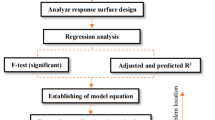Abstract
Composites cast from polyurethane resins, rock aggregates and sand have been examined to determine their resistance to penetration by high velocity projectiles. The effects of using different polymer and rock types have been investigated, and the resultant composite mixes have been optimized using response surface theory to obtain a protective material to clad buildings rapidly and economically. Variables considered in the mix optimization were % polymer, % aggregate, aggregate particle size, and polymer hardness. Penetration tests were carried out on the optimized composites to determine the thickness required for a given confidence level of projectile containment.
Résumé
On a mesuré les caractéristiques de résistance à l'impact de matériaux composites faits de polymères et de granulats rocheux afin de déterminer leur capacité d'utilisation comme matériaux de protection adaptés à des fins particulières. On a considéré divers polymères durcissables à froid, mais la plus grande partie de l'étude expérimentale a porté sur l'utilisation de deux polyuréthanes chargés de sable en tant que matériaux d'enrobage de divers granulats naturels. Ces différentes compositions ont été optimisées en termes de production économique. On a également considéré l'effet de température.
Les expériences ont été conduites avec des projectiles d'un diamètre de 7,62 mm avec une vitesse d'impact régulière d'approximativement 810 m/s et possédant une masse d'environ 9,5 g et conçus en s'appuyant sur la théorie de réponse de surface afin d'étudier l'influence du dosage sur la résistance à l'impact ainsi que des caractéristiques angulaires et des dimensions du granulat, du type de roche et des propriétés du polymère. L'analyse des résultats opérée au moyen d'une optimisation statistique aux différentes étapes de l'expérimentation a permis de déterminer une combinaison pratique des paramètres par lesquels se trouve optimisée la résistance à l'impact.
La meilleure capacité d'absorption de l'énergie a été vérifiée avec une teneur en résine polyuréthane d'environ 10% en poids, 30% de sable «zone 2» et 60% de gravier roulé de rivière renfermant des granulats de grande taille. Les essais statiques ont montré que le matériau est propre à être utilisé en tant que matériau de protection dans la mesure où il ne supporte pas de charge.
Similar content being viewed by others
Abbreviations
- b o tob 44 :
-
coefficients in fitted response surface equations
- D :
-
measured normal penetration depth (mm)
- D′:
-
measured penetration path length (mm)
- D p :
-
predicted normal penetration depth (mm)
- D′ p :
-
predicted penetration path length (mm)
- t m :
-
minimum thickness necessary for containment at a given confidence level (mm)
- x 1 :
-
percentage polymer by weight (%)
- x 2 :
-
percentage rock aggregate by weight (%)
- x 3 :
-
rock aggregate size (mm)
- x 4 :
-
polymer hardness, ShoreA 0
- x iu :
-
level ofi-th factor in theu-th observation
References
Backman M. E., Goldsmith W.—The mechanics of penetration of projectiles into targets. International Journal of Engineering Science, Vol. 16, No. 1, 1978, pp. 1–99.
Butler D. K.—An analytical study of projectile penetration into rock. Army Engineer Waterways Experiment Station. Vicksburg, Missouri, AEWES-TR-S-75-7, 1975.
Yew C. H., Stiribis P. P.—Penetration of projectiles into terrestrial targets. Proceedings American Society of Civil Engineers, Journal of the Engineering Mechanics Division, Vol. 104, No. EM2, 1978, pp. 273–286.
Rohani B.—Analysis of projectile penetration into concrete and rock targets. Army Engineer Waterways Experiment Station, Vicksburg, Missouri, AEWES-MISC-PAPER-S-75-25, 1975.
Bernard R. S.—Development of a projectile penetration theory: Report 2, Deep penetration theory for homogeneous and layered targets. Army Engineer Waterways Experiment Station, Vicksburg, Missouri, AEWES-TR-S-75-9-2, 1975.
Young C. W.—Depth prediction for earth penetrating projectiles Proceedings American Society of Civil Engineers, Journal of the Soil Mechanics and Foundation Division, Vol. 95, No. SM3, 1969, pp. 803–817.
Goodier J. N.—On the mechanics of indentation and cratering in solid targets of strain hardening metal by impact of hard and soft spheres. TR002-64, Poulter Laboratories, Stanford Research Institute, Menlo Park, California, 1964.
Riparbelli C., Brown C. T.—On the mechanism of formation of a crater following impact by a high speed penetrator and a method to predict the crater profile. Proceedings Conference on Rapid Penetration of Terrestial Materials, Texas A and M University, 1972, pp. 281–307.
British Standards Institution.—Specifications for aggregates from natural sources for concrete. B.S. 822, Part 2, 1973.
British Standards Institution.—Methods of sampling and testing mineral aggregates. B.S. 812, Part 2: Physical properties; Part 3: Mechanical properties, 1975.
Cochran W. G., Cox G. M.—Experimental designs. Wiley Publications, New York 1957.
Davies O. L.—The design and analysis of industrial experiments. Oliver and Boyd, London, 1954.
Author information
Authors and Affiliations
Rights and permissions
About this article
Cite this article
Anderson, W.F., Watson, A.J., Johnson, M.R. et al. Optimization of rock/polymer composites to resist projectile penetration. Matériaux et Constructions 16, 343–352 (1983). https://doi.org/10.1007/BF02473815
Issue Date:
DOI: https://doi.org/10.1007/BF02473815




